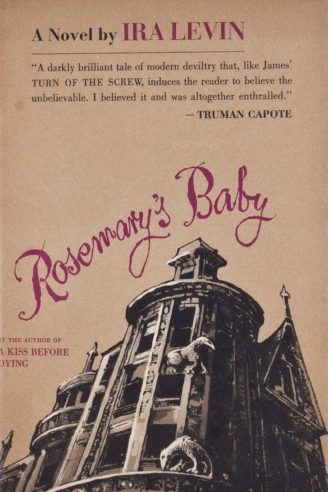 By IRA LEVIN (Random House; 1967)
By IRA LEVIN (Random House; 1967)
ROSEMARY’S BABY may well be the key horror novel of our time. It marked the true start of the horror boom of the 1970s and 80s, a massive bestseller that inspired a just-as-massive big screen adaptation. (See trailer below.) The novel has been somewhat maligned in the ensuing five decades (Marvin Kaye famously dubbed it “overrated,” and derided its “sweet-young-thing-brutalized-by-the-boogeyman plot”), but I say ROSEMARY’S BABY holds up remarkably well overall, with its one major drawback being the fact that, simply, it’s been so widely imitated it doesn’t seem nearly as fresh as it once did.
This may well be the key horror novel of our time.
Drafted in clean, unpretentious prose, the novel tells the story of the young New Yorker Rosemary. She and her actor husband Guy move into the Bramford, an old Manhattan apartment building, despite being sternly warned against doing so by a writer friend who claims that “at the Bramford awful things happen a lot more frequently than now and then.” The place, in short, has a mighty unsavory history, having played host to a number of horrific events over the years, including incidents of cannibalism and witchcraft.
The idea of a haunted, or at least highly forbidding, big city apartment building has become something of a genre standby, but it wasn’t in 1967. The well delineated sense of ancient supernatural evil contained within a (then) contemporary setting is what really gives this novel its charge (even though the approach was by no means unprecedented—see the pre-1960 horror fiction of writers like Richard Matheson and Fritz Leiber). Indeed, the primary reason ROSEMARY’S BABY works so well is that author Ira Levin does a credible job of establishing a sense of normalcy, with the sights and sounds of late 1960s NYC registering as strongly as the supernatural shenanigans that come to dominate the book’s latter half. What’s more, Levin accomplishes this in an extremely economic fashion without overwriting or excess character development, providing an orderly and efficient narrative that never overstays its welcome.
Ira Levin does a credible job of establishing a sense of normalcy, with the sights and sounds of late 1960s NYC registering as strongly as the supernatural shenanigans that come to dominate the book’s latter half.
The Bramford, we learn, is indeed haunted (getting back to Mr. Kaye, he claims “Some critics have tried to make a case for Rosemary’s predicament existing solely in her mind, but nothing Ira Levin wrote substantiates that,” a point with which I’ll have to agree). Rosemary comes to suspect the motives of her elderly neighbors, a nosy pair of coots who when the impregnation portended by the title occurs are a little too solicitous, giving her vile tasting drinks to imbibe. Might said neighbors have ulterior motives involving the witchcraft Rosemary’s pal warned her about? And might one of them actually be the primary individual involved in said witchcraft? I think you can guess the climactic answer to both questions, but getting to that point is great fun.
